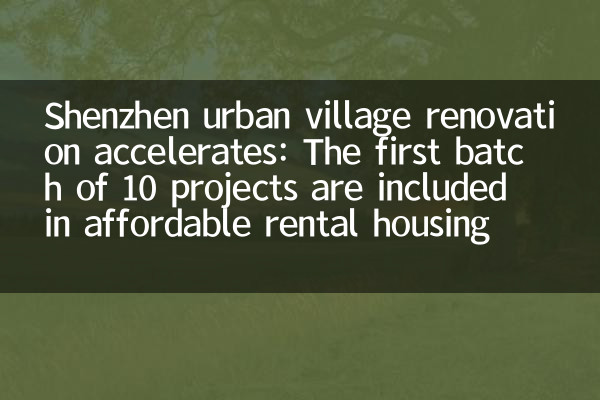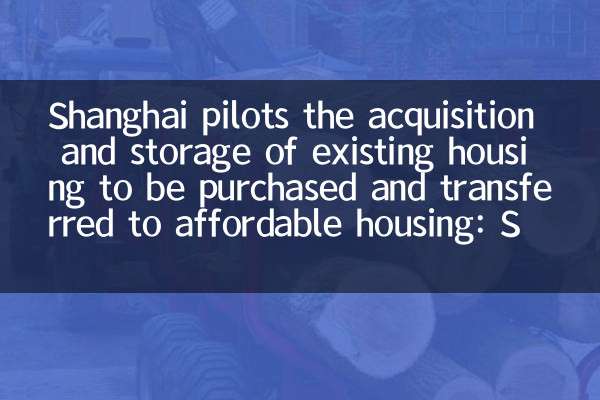Shenzhen urban village renovation accelerates: The first batch of 10 projects are included in affordable rental housing
Recently, Shenzhen’s urban village renovation plan has ushered in major progress, and the first batch of 10 projects have been officially included in the affordable rental housing system. This move aims to alleviate the pressure on urban housing, improve the quality of life of residents, and promote the urban renewal process. The following are detailed analysis and structured data on this topic.
1. Policy background and goals

As a first-tier city in China, Shenzhen has a permanent population of more than 17 million, and the contradiction between housing supply and demand is prominent. As a special product of urban development, urban villages have long had problems such as backward infrastructure and safety hazards. The core goal of this renovation plan is to transform some urban village projects into affordable rental housing, providing affordable housing options for low-income groups and new citizens.
According to data released by the Shenzhen Municipal Housing and Urban-Rural Development Bureau, the first batch of 10 projects included in the renovation are expected to provide about 15,000 affordable rental housing, and the rental level will be lower than 30%-50% of the market price. The following are the basic information of the first batch of projects:
| Project name | Area | Renovation area (10,000 square meters) | Expected properties (sets) |
|---|---|---|---|
| Phase 1 of Baishizhou | Nanshan District | 12.5 | 2500 |
| Dachong New Village | Futian District | 8.3 | 1800 |
| Gangxiadong area | Luohu District | 6.7 | 1500 |
| Xilihu New Village | Bao'an District | 9.1 | 2000 |
| Shangsha Village | Longgang District | 7.8 | 1600 |
| Xiasha Village | Longhua District | 5.6 | 1200 |
| Minzhi New Village | Guangming District | 4.9 | 1000 |
| Bantian North Area | Pingshan District | 6.2 | 1400 |
| Buji Old Street | Yantian District | 5.1 | 1100 |
| Shajing New Village | Dapeng New District | 3.8 | 900 |
2. Renovation model and source of funds
This transformation mainly adopts the "government-led + market participation" model, which specifically includes the following three methods:
1.Unified rental operation: The government will uniformly rent housing in urban villages, and then standardized transformation will be included in the affordable rental housing system. 2.Comprehensive rectification: Repair and upgrade the existing buildings, without involving large-scale demolition. 3.Demolition and reconstruction: Demolish and rebuild some dilapidated buildings or buildings that do not match the planning.
In terms of funds, Shenzhen's finance will invest about 5 billion yuan, and at the same time attract social capital to participate. The following is the allocation of funds:
| Source of funds | Amount (billion yuan) | Percentage |
|---|---|---|
| Municipal Finance | 30 | 60% |
| District-level finance | 10 | 20% |
| Social capital | 10 | 20% |
3. Social response and future planning
The renovation plan has received widespread attention, and most citizens expressed support for the government's measures to solve housing problems. However, some tenants are also worried about rising rents or forced to move. In response, the Shenzhen Municipal Housing and Urban-Rural Development Bureau made it clear that it will ensure the first tenant’s lease rights and provide transitional subsidies.
In the next three years, Shenzhen plans to expand the scope of urban village renovation to 50 projects, and is expected to add 80,000 new affordable rental housing units. The following are the phased goals:
| Time node | Number of target transformation projects | New properties are expected (10,000 units) |
|---|---|---|
| At the end of 2023 | 10 | 1.5 |
| At the end of 2024 | 30 | 4.5 |
| At the end of 2025 | 50 | 8.0 |
4. Summary
The acceleration of urban village renovation in Shenzhen marks the deep integration of urban renewal and housing security system. Through the pilot program of the first batch of 10 projects, the government hopes to explore a replicable and sustainable transformation path to provide reference for other cities. As more projects are implemented, Shenzhen’s housing supply and demand contradiction is expected to be further alleviated, and the city’s appearance will also usher in a new improvement.

check the details

check the details